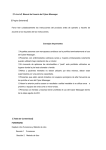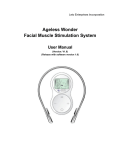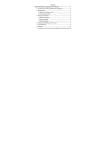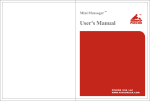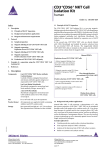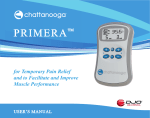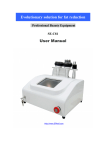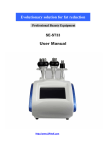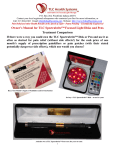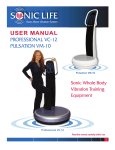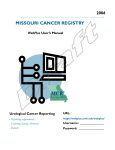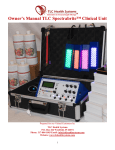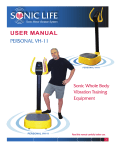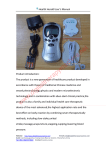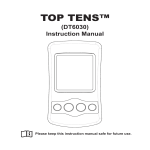Download 6 Mode - Shopify
Transcript
6 Mode This manual only introduces the traditional Chinese health method, not as a basis for treatment disease. Contraindications: Powered muscle stimulators should not be used on patients with cardiac demand pacemakers. Indications for use: To be used for temporary relief of pain associated with sore and aching muscles in the lower back, upper extremities (arm), and lower extremities (leg) due to strain from exercise or normal household work activities. It is intended to stimulate healthy muscle in order to improve or facilitate muscle performance. Warnings: 1. The long-term effects of chronic electrical stimulation are unknown. 2. Stimulation should not be applied over the carotid sinus nerves, particularly in patients with a known sensitivity to the carotid sinus reflex. 3. Stimulation should not be applied over the neck or mouth. Severe spasm of the laryngeal and pharyngeal muscles may occur and the contractions may be strong enough to close the airway or cause difficulty in breathing. 4. Stimulation should not be applied transthoracically in that the introduction of electrical current into the heart may cause cardiac arrhythmias. 5. Stimulation should not be applied trans-cerebrally. 6. Stimulation should not be applied over swollen, infected, or inflamed areas or skin eruptions, e.g., phlebitis, thrombophlebitis, varicose veins, and etc. 7. Stimulation should not be applied over, or in proximity to, cancerous lesions. Content Chapter One Mode Description Chapter Two Analgesia Part One Pain in Trunk and Extremities Part Two Pain in Neck, Shoulders, Waist, Legs and Joints Part Three Common Pain in Organs Part Four Common Gynecological Pain Part Five Headache and Facial Pain Chapter Three Chronic Conditioning Part One Rheumatism Part Two Gout Part Three Premenopausal Syndrome (Hysteria) Part Four Apoplectic Hemiplegia Part Five Functional Dyspepsia Part Six Chronic Gastritis Part Seven Constipation Part Eight Hypertension Part Nine Diabetes Part Ten Insomnia Part Eleven Chronic Bronchitis (Cough) Part Twelve Neurasthenia (Depressed Syndrome) Chapter Four Immunoregulation Chapter Five Troubleshooting Attachment One Common Point Chart Attachment Two Medical Disclaimer Chapter One Mode Description The following chart is a general guideline. We suggest that you initially experiment using each of the 6 modes. The mode or combination of modes that gives you the most desirable sensations and comfort is the most appropriate one to use for your current condition. There is no worry with regards to over-using this device. Adjust the intensity for massage mode. 1) Intensity should be set at a level where you will experience some muscular vibration and involuntary muscle movements. It should be set to give a “comfortable” treatment. The treatment should not or need not be painful. 2) Timing of treatment should be at least 10 to 20 minutes. However, you may treat yourself for as long as you like. 3) Frequency of the treatment should be at one to three times per day. However, you may treat yourself as often as you like. Chronic problems will need more frequency and longer treatments. MODE 1: MODE 2: MODE 3: MODE 4: MODE 5: MODE 6: Tuina Acupuncture Tapping Guasha Body building Combination 1 Chapter Two Analgesia Pain is one of the clinical main gestations of diseases, also the important basis for people to find the diseases. During the treatment, people usually choose analgesics to ease the pain. However, with great side effects, the analgesic is easily to cause hyper-susceptibility and addiction, damage liver and kidney. This massager can effectively relax you, accelerate blood circulation and ease the pain of muscles, joints, and soft tissue. Experiments proved that the analgesia can be realized by stimulating points and local peripheral electrical nerve receptor to improve microcirculation and metabolism, loosen adhesion, relive convulsion and increase the pain threshold. Part One Pain in Trunk and Extremities 1. Pain in trunk Chronic strain, acute strain, injury and hyperosteogeny, etc. by various reasons can cause inflammation, edema, pain in local tissues and limited movement, which usually happen in the neck, shoulders, back, and waist, etc. See Fig. Below 2 3 Parts for Pads There is a saying in the traditional Chinese medicine that “the pressure pain point was selected as needled point”. The very pain point is the key point and the best massage part. Find the pain point according to the Fig. and apply a physiotherapy pad on. The other physiotherapy pad should be applied at the symmetric point of the pain point or near the pain point (but the physiotherapy pad cannot be lapped). If there are several pain points, massage can be done for several times. Choose mode 1 to massage for 40 minutes and use mode 2 for 40 minutes; 2-3 times every day. 2. Pain in the Extremities Pain in extremities is caused by sports injury, over fatigue of soft tissues strain, and other causes, often with ache, adema, and convulsion of muscles. Part for pads: the two pads should be applied at the two ends of painful muscles, or apply one pad on the muscle, and the other on the tendon. The pad location can be adjusted according to your feeling. Use mode 1 for 40 minutes and mode 3 for 40 minutes; 2-3 times every day. Part Two Pain in the Neck, Shoulders, Waist, Legs and Joints 1. Neck Pain Cervical spondylosis, the acute injury, chronic strain and hyperosteogeny in the muscles of neck are the common causes of pain in the neck. 【 treated area and therapy 】 See Fig.4-1 4 Fig. 4-1 Use mode 1 for 40 minutes and mode 2 for 40 minutes; 2-3 times every day. 2. Shoulder Pain Exclude heart diseases for pain in the left shoulder, and liver or gallbladder diseases for the right. Fig. 5-1 【Treated area and therapy】See Fig. 5-1 Find the very pain point and apply the pads at the anterior and posterior shoulders. Use mode 1 to massage for 40 minutes and mode 2 for 40 minutes; 2-3 times every day. 3. Back Pain Fascitis of back is the main cause of pain in back. 【Treated area and therapy】 See Fig. 5-2 Find some pain points in the back to apply the pads respectively. Use mode 1 for 40 minutes and mode 4 for 40 minutes; 2-3 times every day. 5 Fig. 5-2 4. Waist Pain Lumbar disc herniation, acute psoas muscle sprain, chronic lumbar muscle strain and hyperosteogeny can cause pain in waist. 【Lumbar Disc Herniation】 【treated area and therapy】See Fig. 6-1 Use mode 1 to massage A, C for 40 minutes and mode 3 at the B area for 20 minutes; 2-3 times every day. Chronic Lumbar Muscle Strain】 Long term unbalanced position in Fig. 6-1 working which causes fatigue of soft tissues can cause this disease. Delayed treatment to the acute injury in the waist would cause fibrillary with would become scar tissue to oppress the nerves, causing this disease 【treated area and therapy】Find any two pain points in the waist and apply the pads respectively. Use mode 1 for 40 minutes and mode 3 for 40 minutes; 2-3 times every day. 【Sciatica】 【treated area and therapy】See Fig. 6-2 Fig. 6-2 6 Apply the pads according to the Fig. 6-2 Choose mode 1 to massage for 40 minutes and use mode 3 to knock for 20 minutes; 2-3 times every day. 【Lumbar Hyperosteogeny】 【treated area and therapy】 See Fig. 7-1 treated areas. Fig. 7-1 For the two groups, use mode 1 for 40 minutes and use mode 3 for 20 minutes; 2-3 times every day. 5. Joint Pain Acute injury, chronic injury, hyperosteogeny, rheumatism and rheumatoid disease, etc. would cause pain in the joints of elbow wrist, coxa, knee, ankle, and feet, etc. 【Elbow Pain】 【 treated area and therapy 】 See Fig.7-2. Use mode 1 for 40 minutes and mode 3 for 20 minutes; 2-3 times every day. Fig. 7-2 【Mouse Wrist】 【treated area and therapy】 Apply the pads on the internal and external side of wrist in symmetry. Choose mode 1 to massage for 40 minutes and use mode 2 for 20 minutes; 2-3 times every day. 7 Fig. 7-3 Part Three Common Organ Pain This instrument has obvious analgesia effect to the qi expansion pain, dragging pain, and radicular pain, etc. At the same time of relieving patients’ pain, it can generally regulating qi and activate blood flow. The long-term use of this instrument can consistently treat some diseases of organs. 【 Stomachache 】 Stomachache, the upper abdominal pain, is a common symptom caused by gastricism, ulcer inflammation, stomach convulsion and biliary diseases. The traditional Chinese medicine holds that although pain causes are different, all can be classified into disorder of visceral qi, which ensues pain. 【treated area and therapy】See Fig 8-1. Fig. 8-1 Choose mode 1 to massage A for 40 minutes and use mode 6 to massage B for 40 minutes; 2-3 times every day. 【Notice】 1 Forbidden to patients with gastric ulcer in the hemorrhage period. ○ 2 Pay attention to the diet regulation and avoid over-fatigue ○ 【Liver Pain】It is the distending pain and dull pain in liver, chest and flank which is caused by hepatosplenomegaly of the patients with acute and chronic hepatitis which involves surrounding tissues and 8 nerves, or stiffness caused by liver qi. 【treated area and therapy】See Fig. 9-1 Fig. 9-1 Choose mode 3 to massage A for 40 minutes and use mode 1 to massage B for 40 minutes; 2-3 times every day. Part Four Common Gynecological Pain Around the period of women, pain in the lower abdomen appears which is called as painful menstruation. Blocked qi blood is the main cause of painful menstruation 【treated area and therapy】See Fig. 9-2 Fig.9-2 9 Choose mode 1 to massage A for 40 minutes and use mode 2 for 20 minutes; 2-3 times every day. Choose mode 1 to massage B and C for 40 minutes and use mode 6 for 20 minutes; 2-3 times every day. 【Breast Hyperplasia Pain】 【treated area and therapy】Apply the pads at any two pain points on the breasts. Avoid the electrode from the nipples. Choose mode 1 to massage for 40 minutes and use mode 6 for 20 minutes; 2-3 times every day with proper strength. Part Five Headache and Facial Pain As a kind of symptom, headache appears in various acute and chronic diseases. It is the pain caused by cerebral organic lesion, which does not belong to the application range of this instrument. Besides, this instrument can relieve all headaches, with obvious analgesia effects to migraine, muscular contraction headache, headache of cold, vascular headache and hypertension complicated headache especially. Except to the recommended parts, the apply location can be any part where pains. 【Migraine】Migraine belongs to the constitution disease, which is usually relative to the inheritance. Fatigue, tension, or period can also cause it. The pain located at one side of the head, mostly in the youngsters. 【treated area and therapy】 See Fig.10-1. Choose mode 4 to massage A for 40 minutes; Choose mode 2 for B 10 for 40 minutes with mild to great force; 2-3 times every day. 【Trigeminal Neuralgia】Wind chill, mental stimulation, oral disease or local tumor can cause trigeminal neuralgia, which is common in the middle-aged and the old. 【treated area and therapy】See the above Fig. for B and C. Choose mode 1 to massage for 40 minutes and use mode 3 to knock for 20 minutes; 2-3 times every day. 【Notice】If the trigeminal neuralgia is caused by space occupying lesion, surgery should be taken in time. Chapter Three Chronic Conditioning Part One Rheumatism It is a kind of systemic chronic disease. With unclear cause, it belongs to the bi syndrome of bone of the traditional Chinese medicine. Patients have migratory joints pain and dysfunction in the early phase, which is also called as “pain in running”. And the joints would become stiff, deformed, and dysfunctional in the late phase. This disease is common in the youngsters and the rate of women is 3 times of men. 【treated area and therapy】Apply the pads at any two pain points. Choose mode 1 to massage for 40 minutes and use mode 3 to knock for 40 minutes; 2-3 times every day. Part Two Gout There is a substance named as purine in human body, and gout would be cause by its metabolic disorder. Patients are mostly the middle-aged or older. Gout can be caused by bibulosity, surfeit, 11 fatigue, and inflammation, etc. 【treated area and therapy】Apply the pads at any two pain points. Choose mode 1 to massage for 40 minutes and use mode 4 to acupuncture for 40 minutes; 2-3 times every day. Part Three Perimenopausal Syndrome (Hysteria) Perimenopausal syndrome refers to the transition of women from child-bearing age to old age (about 45 to 55 years old), due to ovarian dysfunction caused by a series of changes to the organism. The main symptoms are cardiovascular symptom, energetic symptom and metabolism barrier caused by nerves autonomic function being out of balance. 【treated area and therapy】 Choose mode 1 to massage A for 30 minutes and use mode 2 for 20 minutes; Choose mode 4 to massage B or use mode 6 to massage C for 30 minutes; 2-3 times every day. Fig. 12-1 Part Four Apoplectic Hemiplegia 1 Early phase (period of flaccid paralysis): with steady vital signs ○ and clear consciousness, under the doctor’s advice, the patients can begin the therapy of group A till the affected limb can initiatively 12 move. 2 Recovery phase (convulsion paralysis): once the affected limb ○ can initiatively move, the patient can begin the therapy of group B. Electrode pad position of group A. Apply the electrode pad at the muscle belly of biceps and triceps according to Fig. 13-1. Choose mode 1 to massage for 40 minutes and use mode 2 for 20 minutes; 2-3 times every day. Fig. 13-2 Fig. 13-1 Fig. 13-3 Fig. 13-4 Apply the pads at the forearm extensors according to Fig. 13-2. Choose mode 1 to massage for 40 minutes, 2-3 times every day Apply the electrode pad at the flexors of the forearm according to Fig. 13-3. Fig. 13-5 Choose mode 1 to massage for 40 minutes; 2-3 times every day. Apply the pads at the inner and outer head of the quadriceps femoris according to Fig. 13-4. Choose mode 1 to massage for 40 minutes, and use mode 3 to knock for 20 minutes, 2-3 times every day. Apply the pads at the tibialis anterior muscle according to Fig. 13-5 . Choose mode 1 to massage for 40 minutes, and use mode 3 for 20 minutes, 2-3 times every day. Pole pad position of group B. Apply the pole pads at the forearm extensors according to Fig. 14-1. 13 Choose mode 1 to massage for 40 minutes, 2-3 times every day. Apply the pads at the Fig. 13-1 triceps according to Fig. Fig. 13-2 14-2 Choose mode 1 to massage for 40 minutes, and use mode 3 for 20 minutes, 2-3 times every day. Apply the pole pads at Fig. 13-3 Fig. 13-4 the tibialis anterior muscle according to Fig. 14-3. Choose mode 1 for 40 minutes, and use mode 3 for 20 minutes, 2-3 times every day. Apply the pads at the biceps femoris according to Fig. 14-4. Use mode 4 to knock for 20 minutes; 2-3 times every day. 【Notice】 1 Follow regular treatment principle. The treatment should be taken ○ when the patients have steady vital sign and recovered consciousness. 2 Group A therapy is only fit for patients in the period of flaccid ○ paralysis (no independent movement in the affected limb). The treatment force is proper when effective contract of all muscle groups appear. 3 The stimulation to flexor groups of upper limb and the extensor ○ group of lower limb is forbidden. 4 Other therapies during the treatment should be kept. ○ 5 Patients with epilepsy should be cautious to this therapy. ○ Part Five Functional Dyspepsia 14 Functional Dyspepsia is indigestion or an upset stomach or which there is no detectable structural cause, such as an ulcer, but rather, a functional reason, such as muscles or nerves that control the organs not functioning properly. It is very common. Symptoms of dyspepsia include a pain or burning feeling in the upper abdominal area, belching, nausea, and sometimes vomiting, and bloating. These symptoms often come after eating. 【treated area and therapy】 Choose mode 1 to massage A for 30 minutes and use mode 2 for 20 minutes; Choose mode 6 to massage B for 20 minutes; twice every day. Fig. 15-1 Part Six Chronic Gastritis Chronic gastritis is a chronic gastric lesion, pathologically characterized by nonspecific chronic inflammation of the gastric mucosa. Chronic gastritis has vague symptoms, including abdominal discomfort or pain, poor appetite and irregular bowel movements. Fig. 15-2 【treated area and therapy】See Fig.15-2. 15 Choose mode 1 to massage A for 40 minutes; Choose mode 6 to massage B for 40 minutes; twice every day. Part Seven Constipation Constipation is defined as having a bowel movement fewer than three times per week. With constipation stools are usually hard, dry, small in size, and difficult to eliminate. Some people who are constipated find it painful to have a bowel movement and often experience straining, bloating, and the sensation of a full bowel. 【treated area and therapy】See Fig.16-2 (1) (2) Fig. 16-1 Choose mode 1 to massage A for 40 minutes; Choose mode 6 to massage B for 40 minutes; 2-3 times every day. Choose mode 4 to massage C for 40 minutes; Choose mode 6 to massage B for 40 minutes; 2-3 times 16 Part Eight Hypertension Hypertension is a common cardiovascular disease, with systemic arterial blood pressure increases as the main performance of the sustainability of clinical syndrome. In China, a common complication of hypertension is cerebrovascular accident, followed by hypertensive heart failure, renal failure, etc. 【treated area and therapy】 Choose mode 2 to massager A for 40 minutes; Choose mode 6 to massage B for 40 minutes; 2-3 Fig. 17-1 times every day. Part Nine Diabetes Diabetes produces the classical symptoms of polyuria (frequent urination), polydipsia (increased thirst) and polyphagia (increased hunger). Diabetes can lead to infection, heart attack, cerebral vascular disease, kidney failure, blindness and lower limb gangrene, etc. become the main reason for the death and disability. Fig. 17-2 【treated area and therapy】 (1) Choose mode 1 to massage A for 40 minutes; Choose mode 6 to massage C for 40 minutes; 2-3 times every day. (2) Choose mode 1 to massage B for 40 minutes; Choose mode 6 to massage C for 40 minutes; 2-3 times every day. 17 Part Ten Insomnia Insomnia is a sleep disorder that is characterized by difficulty falling and/or staying asleep. People with insomnia have one or more of the following symptoms: difficulty falling asleep; waking up often during the night and having trouble going back to sleep; waking up too early in the morning; feeling tired upon waking. Use our product can help you to fall asleep and improve sleep quality. 【treated area and therapy】See Fig.18-1. (1) (2) (3) Fig. 18-1 Choose mode 2 to massage A for 40 minutes; Choose mode 6 to massage C for 40 minutes; 2-3 times every day. Choose mode 1 to massage B for 40 minutes; Choose mode 6 to massage C for 40 minutes; 2-3 times every day. Choose mode 6 to massage B for 40 minutes; 2-3 times every day Part Eleven Chronic Bronchitis (Cough) Chronic bronchitis is defined as a cough that occurs every day with sputum production that lasts for at least three months, two years in a row. It is an inflammation of the main airways in the lungs that continues for a long period or keeps coming back. 18 【treated area and therapy】See Fig.19-1 Choose mode 2 to massage A for 40 minutes; Choose mode 4 to massage B for 40 minutes, then use mode 6 to massage for 20 minutes; 2-3 times every day. Fig. 19-1 Part Twelve Neurasthenia (Depressed Syndrome) Neurasthenia is characterized by general lassitude, irritability, lack of concentration, worry, and hypochondria. When neurasthenia occurs, autonomic nervous system will become disorder, the immune system function will be abnormal, and various intractable diseases will appear. 【treated area and therapy】See Fig.19-2. Choose mode 2 to massage A for 40 minutes; Choose mode 1 to massage B for 40 minutes, then use mode 6 to massage for 30 minutes; 2-3 times every day. Fig. 19-2 19 Chapter Four Immunoregulation Immunity refers to the ability of an organism to resist disease, either through the activities of specialized blood cells or antibodies produced by them in response to natural exposure or inoculation (active immunity) or by the injection of antiserum or the transfer of antibodies from a mother to her baby via the placenta or breast mild (passive immunity). This massager combines the bioelectrical information with massage and acupuncture, etc. of the traditional Chinese medicine, adopts modern micro-electronic technology, computer embedded software technology and simulation by modern electro-physiological theory and the meridian theory of the traditional Chinese medicine. Long-standing use of this product can enhance human immunity. 【treated area and therapy】See Fig.20-1 (1) (2) Fig. 20-1 Choose mode 2 to massage A for 40 minutes; Choose mode 6 to massage C for 40 minutes; 2-3 minutes every day. Choose mode 4 to massage B for 40 minutes; Choose mode 6 to massage C for 40 minutes; 2-3 times every day. 20 Chapter Seven Troubleshooting PROBLEM CAUSE SOLUTION One pad feels stronger than the other. This is normal. Different areas of your body will react differently. Nothing needs to be done. Make sure the pads are moist and are making good contact. During the massage, the skin feels a painful burning sensation or the stimulation becomes weakened. Adhesive gel pads are not adhering firmly to the skin. Or the gel pads are too dry. Apply a few drops of water to adhesive surface of each pad and make sure the pads are pressed firmly to the skin during application. Unit is on, but no sensation is felt in the pads Both pads are not firmly on the skin. Or there is a loose connection. Or the intensity level needs to be increased Make sure both pads are firmly pressed to the skin. Make sure all connections are secure from the unit to the wires and the wires to the pads. Increase the intensity level 21 PROBLEM CAUSE SOLUTION Adhesive gel pads do not stick to skin even after cleaning and moistening the gel pad. Adhesive gel pads need to be replaced Replace the set of pads. Original pads need to be purchased. Unit does not turn on or the screen is dim. Battery is low Recharge the battery Does not provide adequate pain relief. Not using it long enough or frequently enough. Not lying down when massaging neck. Use your massager 20-30 minutes at a time, 3-6 times per day. Lie on your back for neck support when you need relief for headaches or neck pain. 22 Attachment One: Common Point Chart Tiantu Zhonfu Qimen Tianshu Qihai Guanyang Zhongji Dahe Huiyin Zusanli Fenglong Sanyinjiao 23 24 25 Attachment Two: Medical Disclaimer All information is intended for your general knowledge only and is not a substitute for medical advice or treatment for specific medical conditions. We cannot and do not give you medical advice. You should seek prompt medical care for any specific health issues and consult your health care provider before purchasing any product(s).The information contained in User’s Manual is intended to provide broad consumer understanding and knowledge of products offered. The information should not be considered complete and should not be used in place of a visit, call, consultation or advice of your health care provider. Should you have any health care-related questions, please call or see your health care provider promptly. You should never disregard medical advice or delay in seeking it because of something you have read here. 26 Note 27






























